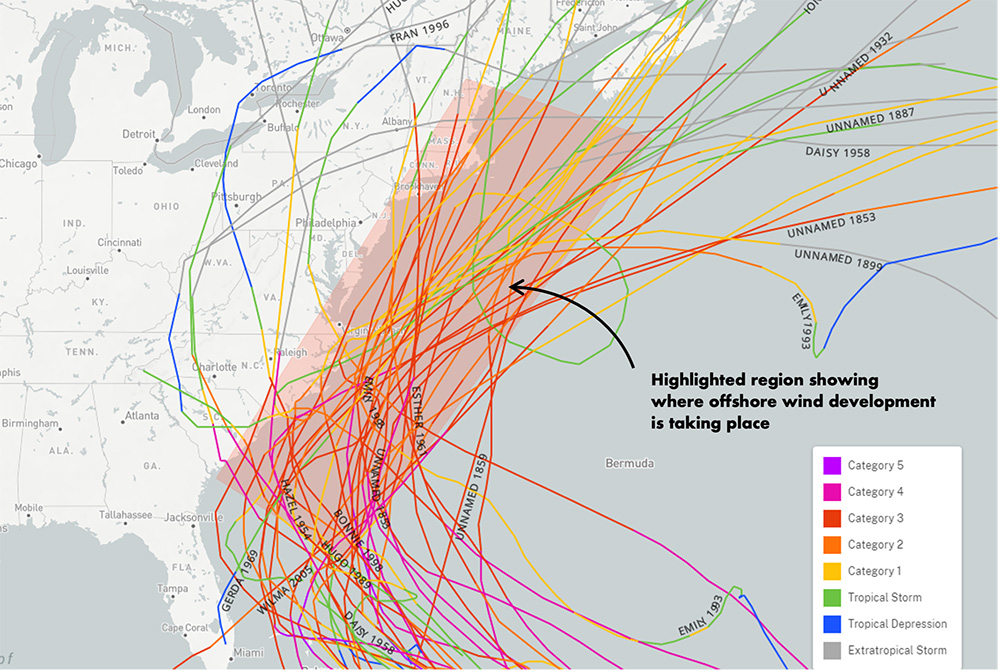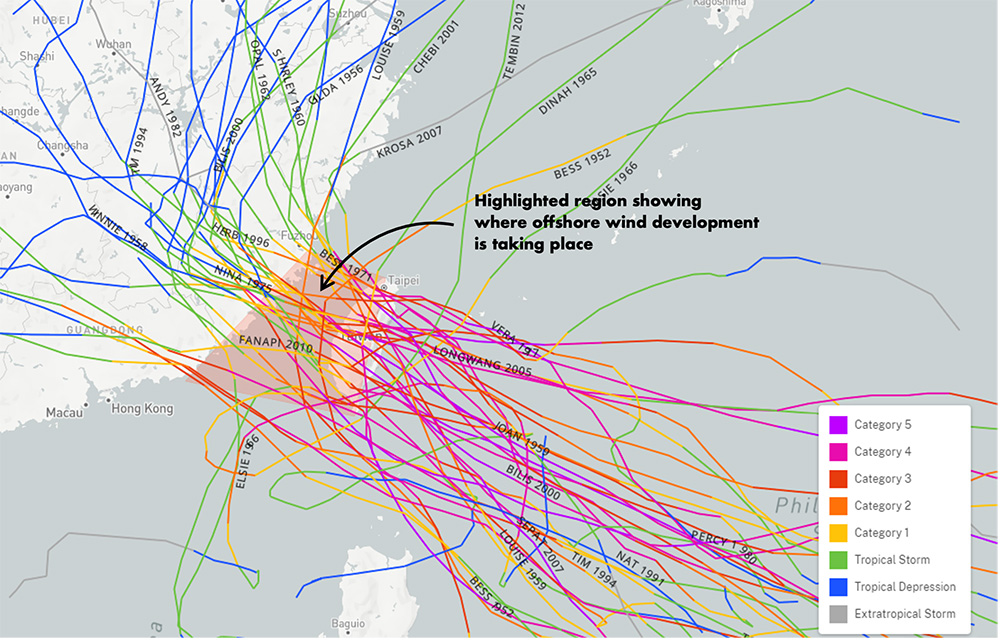To underwrite against tropical cyclones insurers are relying upon natural catastrophe (NATCAT) modelling, technology classification and turbine manoeuvres. These are either untested or inadequate.
Tropical cyclones – known as Hurricanes if formed in the North Atlantic, central North Pacific, and eastern North Pacific, or typhoons if formed in the Northwest Pacific1 – and the risk of resulting damage is a growing concern for renewable energy insurers as offshore wind developers plan more projects in Taiwan and across the U.S. East Coast.
Figure 1: Hurricane tracks for category 3-5 for all years (zoomed in on the U.S. East Coast).

Figure 2: Hurricane tracks for category 3-5 for all years (zoomed in on the U.S. East Coast).

Tropical cyclones are a concern during transport, storage, installation and the operational lifetime. Exposures can be mitigated during transport and installation by avoiding works during the peak wind season and with harbouring and equipment storage protocols. For the U.S. the Atlantic hurricane season occurs between June and November; for Taiwan, the typhoon season in Asia tends to be between May and October. But once installed, the exposure is fixed throughout the operational lifetime.
Off-the-shelf NATCAT models are currently inadequate for evaluating the vulnerability of offshore wind projects. The weather data is good — past tracks can be used to estimate the likelihood and severity of a tropical cyclone passing by an offshore wind project. The damage ratios and vulnerability estimates for the modelled turbines are not. While some models are catching up, for many, a wind turbine is modelled like a tall building . Unlike traditional property, a wind turbine is designed to catch the wind and can manoeuvre in multiple directions (rotor yaw and blade pitch). It most likely means that models are overestimating primary damage.
The wind turbines should be certified to the IEC 61400-1 standard, and specifically class T (T – tropical storm/typhoon) if applicable (Class S gives a turbine maker an option to design a turbine with unique conditions outside of traditional classes). Site wind characteristics should always be compared to the most applicable wind class for the site. Put simply, the standard describes the wind speeds that the turbine must withstand. For tropical cyclones it lists 57 metres per second as an average wind speed over 10 minutes. Otherwise, it follows the same standards as a class I (high wind speed site).
One challenge facing turbine makers and standards committees is selecting the design parameters when few physical test cases exist. Another challenge is comparing site characteristics to turbine design standards when the metrics don’t align. Quoted hurricane speeds are normally those that follow the Saffir-Simpson hurricane scale, that being the peak 1-minute wind speed at a height of 10 meters.2 Wind turbine design standards are applied for wind speeds at hub height – around 150 meters for the latest offshore wind turbines. Although wind shear (how wind speed changes with height above a surface) is low offshore, it could still make a category 2 hurricane at 10m measure at category 3 speeds at 150m.3
A quick desk review of past tracks of major storms (category 3-5 on the Saffir-Simpson hurricane scale) show that by the time they reach the offshore wind development zones they are downgraded to a category 2-3 – normally downgraded due to lower sea temperatures. The industry seems to broadly accept that a class I wind speed turbine should withstand a category 2 hurricane.
Withstanding any kind of high winds requires manoeuvring the turbine. It needs to be yawed out of the wind with blades pitched at an angle to prevent lift and the rotor spinning. To do this requires power. To mitigate for a grid connection failure (in the event of a tropical cyclone) it is generally accepted that a yaw back-up system be present on each wind turbine and supported by an uninterruptible power supply – such as a battery – normally at the base of the tower.
Storm modes can also reduce fatigue on a wind turbine during a tropical cyclone. It works by reducing a turbine’s power output (known as de-rating) at higher wind speeds. It avoids a turbine altering between cutting-in and cutting-out during the variable wind speeds of a storm (or tropical cyclone).
Despite the challenges, there is an abundance of experience in underwriting tropical cyclone exposures. For example, the energy market (oil and gas) has a wealth of knowledge in risk transfer for platforms in the Gulf of Mexico. In that market, NATCAT risks are often rated separately to – but on the same policy as – the All Other Perils premium. This could make sense for other lines of business too. And for Gulf of Mexico wind, this experience has led to better weather data, loss data and experience in interpreting NATCAT models.
Nardac has successfully bridged reinsurance solutions from other lines of business and underwriters in different classes to carve-out NATCAT solutions on offshore wind projects. Our role is to identify who is best placed to carry risks at the most economic cost. If (re)insurance costs continue to rise, and margins for developers, contractors and suppliers continue to fall, the expansion of offshore wind that we all need to meet decarbonisation targets will not materialise.
- https://oceanservice.noaa.gov/facts/cyclone.html
- https://www.nhc.noaa.gov/pdf/sshws.pdf
- Assuming a 50m/s speed (178km/h – cat 3 lower limit) at 150m and a surface roughness of 0.0002 (water surface).